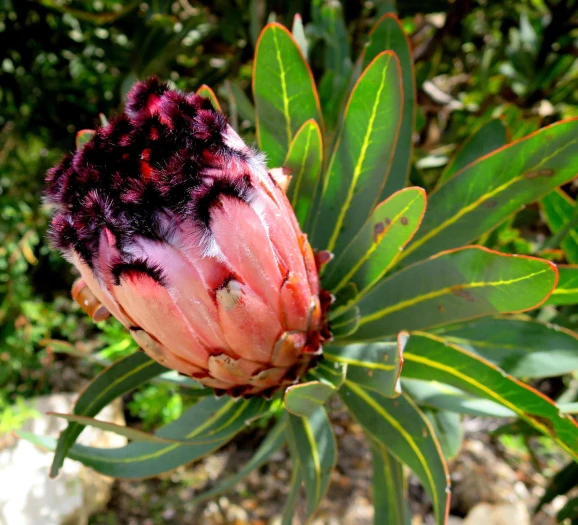Oleander-Leaf Protea
(Protea neriifolia)
Oleander-Leaf Protea (Protea neriifolia)
/
/

Di Turner
Public Domain
Image By:
Di Turner
Recorded By:
Copyright:
Public Domain
Copyright Notice:
Photo by: Di Turner | License Type: Public Domain | License URL: http://creativecommons.org/publicdomain/zero/1.0/ | Rights Holder: Di Turner | Publisher: iNaturalist | Date Created: 42450 |




















































Estimated Native Range
Climate Requirements for New York, New York
| This Plant | Your Site | Plant Suitability for Your Location | ||
|---|---|---|---|---|
| • Precipitation | 8" - 61" | 46" | Aquatic | Aquatic |
| • High Temp. | 70°F - 90°F | 85°F | Your summer temperatures are normal for this plant. | Excellent |
| • Low Temp. | 34°F - 65°F | 24°F | Your winter temperatures may be too cold for this plant | Too cold |
This plant may not grow well at your location - your precipitation is too high.
Summary
Protea neriifolia, commonly known as Oleander-Leaf Protea, is an evergreen shrub native to the fynbos region of the Cape in South Africa. It typically grows to a height of 4-6 feet and a width of 6-8 feet. The plant is characterized by its narrow, leathery leaves that resemble those of the oleander, and its large, showy flowers which are usually pink and appear in the spring and summer. The blooms are composed of a central mass of long-lasting, colorful bracts that surround the true flowers, making them particularly attractive in the garden and as cut flowers.
Oleander-Leaf Protea is valued for its striking flowers and adaptability to garden conditions. It is a popular choice for ornamental plantings and is widely cultivated for the cut flower industry. The plant thrives in full sun and requires well-drained soil, tolerating low water conditions once established. It is susceptible to root rot if overwatered or planted in poorly drained soils. In cultivation, it is important to avoid disturbing the roots, as proteas are sensitive to root disturbance. ’Green Ice’, ’Margaret Watling’, and ’Silvertips’ are notable cultivars, while ’Carnival’ and ’Pink Mink’ are hybrids that have been developed for their unique flower colors and forms.CC BY-SA 4.0
Oleander-Leaf Protea is valued for its striking flowers and adaptability to garden conditions. It is a popular choice for ornamental plantings and is widely cultivated for the cut flower industry. The plant thrives in full sun and requires well-drained soil, tolerating low water conditions once established. It is susceptible to root rot if overwatered or planted in poorly drained soils. In cultivation, it is important to avoid disturbing the roots, as proteas are sensitive to root disturbance. ’Green Ice’, ’Margaret Watling’, and ’Silvertips’ are notable cultivars, while ’Carnival’ and ’Pink Mink’ are hybrids that have been developed for their unique flower colors and forms.CC BY-SA 4.0
Plant Description
- Plant Type: Shrub
- Height: 4-6 feet
- Width: 6-8 feet
- Growth Rate: Moderate
- Flower Color: Orange, Pink
- Flowering Season: Spring, Summer
- Leaf Retention: Evergreen
Growth Requirements
- Sun: Full Sun
- Water: Low
- Drainage: Medium, Fast
Common Uses
Bee Garden, Bird Garden, Butterfly Garden, Hummingbird Garden, Showy Flowers
Natural Habitat
native to the fynbos region of the Cape in South Africa
Other Names
Common Names: Narrow-Leaf Sugarbush, Oleander-Leaved Sugarbush, Blue Sugarbush, Oleanderprotea
Scientific Names: Protea neriifolia, Scolymocephalus neriifolius
GBIF Accepted Name: Protea neriifolia R.Br.